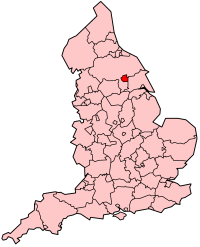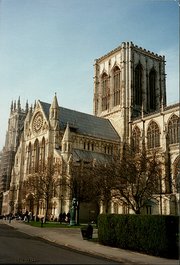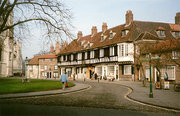York
|
|
- This article is about the English city. For other meanings, see York (disambiguation).
| City of York | |
|---|---|

| |
| Geography | |
| Status: | Unitary, City |
| Region: | Yorkshire and the Humber |
| Ceremonial County: | North Yorkshire |
| Area: - Total | Ranked 166th 271.94 km² |
| Admin. HQ: | York |
| ONS code: | 00FF |
| Demographics | |
| Population: - Total (2003 est.) - Density | Ranked 77th 183,128 673 / km² |
| Ethnicity: | 97.8% White |
| Politics | |
| York City Council http://www.york.gov.uk/ | |
| Leadership: | Leader & Cabinet |
| Executive: | Liberal Democrats |
| MPs: | Hugh Bayley, John Greenway, John Grogan |
York is a city in Northern England, built at the confluence of the Rivers Ouse and Foss. In 2003 the city had a population of 183,128. Its geographic coordinates are Template:Coor dm.
| Contents |
Overview
York is the traditional county town of Yorkshire, to which it lends its name. However, it did not form part of any of the three ridings of Yorkshire. The modern City of York, created on April 1, 1996, is a unitary authority and an administrative county in its own right. As well as York itself, it includes a number of neighbouring parishes which formerly belonged to the surrounding districts of Harrogate, Ryedale and Selby. It borders on North Yorkshire and the East Riding of Yorkshire.
The city will be 2,000 years old in 2071, and has a rich Roman and Viking history. The historical aspects of York attract a great deal of tourism. York is also known for its chocolate factories, and is home to the University of York.
The city sometimes suffers from flooding.
History and tourism
See History of York
Roman York
York is renowned for its history, which is preserved in its architecture. The city was founded in AD 71, and for much of the intervening period has been the main city in the North of England. Every year, thousands of tourists flock to see the surviving mediaeval buildings, interspersed with Roman and Viking remains. The City Council has 27 Conservation Areas, no fewer than 2084 Listed buildings and 20 Scheduled Ancient Monuments in its care.
For the Romans, York ("Eboracum") was a major military base; Emperor Septimius Severus died there in AD 211, and Constantius Chlorus, the father of Constantine I, died there in 306. In York, Constantine's troops proclaimed him emperor (note that the only other city in which an emperor has been proclaimed is Rome itself). Substantial Roman remains were discovered under the Minster and a re-erected Roman column now stands on Deangate. There are also the remains of a Roman bath, but a temple and the site of the Roman bridge over the River Ouse have also been excavated lately. Outside the city walls are the remains of substantial Roman cemeteries. A large number of Roman finds are now housed in the Yorkshire Museum.
Paulinus of York brought Christianity to the region in the early 7th century with the conversion of King Edwin of Northumbria and the first Minster is believed to have been built in 627, although the location of the early Minster is a matter of dispute. York became a centre of learning, its most famous scholar being Alcuin.
Viking York
- For Viking York, see Jorvik.
A "great Viking army" captured York in AD 866, and in 876 the Vikings settled permanently in parts of the Yorkshire countryside. Viking kings ruled this area, known to historians as "The Viking Kingdom of Jorvik", for almost a century. In 954 the last Viking king, Eric Bloodaxe, was expelled and his kingdom was incorporated in the newly consolidated Anglo-Saxon state. Another renowned scholar of this era was Wulfstan II, Archbishop of York.
Mediaeval York
Following the Norman Conquest of 1066, York was substantially damaged by the punitive Harrying of the North (1069) launched by William the Conqueror in response to regional revolt. Two castles were erected in the city on either side of the River Ouse. In time York became an important urban centre as the administrative centre of the county of Yorkshire, as the seat of an archbishop, and at times in the later 13th and 14th century as an alternative seat of royal government. It was an important trading centre. Several religious houses were founded following the Conquest, including St Mary's Abbey and Holy Trinity Priory. The city as a possession of the crown also came to house a substantial Jewish community under the protection of the sheriff.
On March 16, 1190 a mob of townsfolk forced the Jews in York to flee into the wooden castle, which was under the control of the sheriff. The castle was set on fire and the Jews were massacred. It is likely that various local magnates who were indebted to the Jews helped instigate this massacre or, at least, did nothing to prevent it. Commemoration of the York massacre passed into the Jewish liturgy and until 1990 orthodox Judaism forbade Jews from living within the city.
York prospered during much of the later mediaeval era and this is reflected in the built environment. York Minster is the largest mediaeval cathedral in England and one of the largest gothic churches in Europe. The mediaeval city walls, with their entrance gates, known as bars, encompassed virtually the entire city and survive to this day.
York_Shambles.jpg
The later years of the 14th and the earlier years of the fifteenth centuries were characterised by particular prosperity. It is in this period that the regular cycle of religious pageants (or plays) associated with the Corpus Christi cycle and performed by the various craft guilds grew up. Among the more important personages associated with this period was Nicholas Blackburn senior, lord mayor in 1412 and a leading merchant. He is depicted in glass in the (now) east window of All Saints church in North Street. The period from the later 15th century seems to have witnessed economic contraction and a dwindling in York's regional importance. The construction of the city's new guildhall around the middle of the century can be seen as an attempt to project civic confidence in the face growing uncertainty.
Dating from the later mediaeval era, and now a popular tourist attraction, is the Shambles, an old street with overhanging timber-built shops, now occupied by souvenir shops as opposed to the original butchers. York is also home to numerous Ghost Walks and also a favourite venue for hen parties.
Modern York
York_city.jpg
As well a tourist destination, modern York is a centre of communications, education and manufacturing. It is a major railway junction, situated on the East Coast, Cross Country and Transpennine mainlines.
York is also a major venue for horse racing, at York Racecourse in the Knavesmire area.
Two large factories make chocolate (Nestlé Rowntree and Terry's), while another refines sugar. York is the home of KitKat, Smarties, the Chocolate Orange and the eponymous Yorkie bar. However, in April 2004, Terry's announced their intention to close their York-based operations.
The city has one of the country's leading universities (the University of York) — ranking 2nd in the 2001 Daily Telegraph university league table — a higher education college (York St John College) and a branch of the College of Law. The City's football team (York City) was relegated from the Football League to the Nationwide Conference at the end of the 2003/4 season. York also has a rugby league side, York City Knights. The York area is served by a local newspaper, the Yorkshire Evening Press.
York is also noted for its wealth of pubs. The York area is said to contain one pub for every day of the year, although this is now a little exaggerated. It is said, with perhaps a touch of poetic licence, that there is no point within the city walls where one can stand and not be able to see at least one pub and at least one church.
The city is prone to severe flooding from the River Ouse, and has an extensive (but not always effective) network of flood defences. These include walls along the Ouse and a barrier across the Foss (see River Foss). Much land within the city has always been too flood-prone for development. Partly as a result of this, there is an unusual amount of green space. The ings are flood meadows along the River Ouse, while the strays are scattered around the city in marshy, low-lying places; another such area is the Knavesmire. In summer, when they are drier, these areas are used for recreation, and some are grazed by cattle.
Etymology
This city was originally named by the Celts as Eborakon, which means "place of yew trees". The Yew was Efrawg in Brythonic, Efrog in Welsh, Eabhrac in Irish Gaelic, Iorc in Scottish Gaelic. As York was a town in Roman times, its Celtic name is recorded in Roman sources, as Eboracum and Eburacum, with the ending Latinized.
After 400 AD Anglo-Saxons took over the area and adapted the name to Anglo-Saxon Eoforwīc, which means "wild-boar dairy-farm". An earlier form of Anglo-Saxon eofor is Common Germanic *eburaz. York became Northumbria's centre of power later on.
The Vikings took over the area later and changed the name again, to Jórvík, meaning "Horse Bay" (the same as a place in modern Bohuslän in Sweden). York is on a navigable river and so was used as a port; the Vikings often gave ports names ending in vík, as ports are often in bays and inlets.
After the Norman Conquest, the name later changed to "York".
York and Quakers
York has a long association with the Religious Society of Friends. The York-born Quaker chocolate entrepreneurs and social reformers Joseph Rowntree and Benjamin Seebohm Rowntree left an indelible mark on the city, through both their business interests and their philanthropy. They built the village of New Earswick to provide quality affordable housing for their employees. They also founded two Quaker schools, and contributed in large part to the building of York Public Library and the creation of Rowntree Park. The four Rowntree trusts, funded from the Rowntree legacies, are based in York.
The Retreat is a large Quaker mental hospital in the Walmgate area of the city. It was founded in 1796 by William Tuke; over the next century his son Henry Tuke, grandson Samuel Tuke and great-grandson Daniel Hack Tuke also devoted themselves to mental health reform, continuing to reform The Retreat and publishing a number of works on the subject. Another notable York Quaker was the sculptor Austin Wright.
Places of interest (City Centre)
Mallard_locomotive_625.jpg
- Archaelogical Resource Centre
- Assembly Rooms, a grand Palladian public space designed by Lord Burlington, 1731–32, lies behind a rebuilt 19th century facade.
- Bar Convent Museum
- Barley Hall
- Clifford's Tower
- Jorvik, The Viking City
- The King's Manor
- Merchant Adventurers' Hall
- Micklegate Bar Museum
- National Railway Museum
- National Centre for Early Music, home of the York Early Music Festival [1] (http://www.ncem.co.uk/yemf.shtml)
- Saint Mary's Abbey
- Treasurer's House
- York Castle Museum
- York City Art Gallery
- York City Walls (Including Monk Bar Museum)
- York Dungeons
- York Minster
- Yorkshire Museum
Places of interest (Suburbs and Villages)
- Archbishop's Palace, Bishopthorpe
- Askham Bogs
- Askham Bryan Hall
- Elvington Hall
- Haxby Hall
- Heslington Hall
- The Knavesmire
- Middlethorpe Hall, Middlethorpe Manor
- Osbaldwick Hall
- Skelton Hall, Skelton Manor
- Vale of York
- West Huntington Hall
- York Racecourse
- Yorkshire Air Museum, Elvington
- Yorkshire Museum of Farming, Murton
Districts, towns, villages
- Acaster Malbis, Acomb, Askham Bryan, Askham Richard
- Bishopthorpe, Bootham
- Clifton, Copmanthorpe, Crockey Hill
- Deighton
- Dunnington
- Elvington
- Fishergate, Fulford
- Haxby, Heslington, Hessay, Heworth, Holgate, Holtby, Huntington
- Layerthorpe
- Kexby, Knapton
- Middlethorpe, Moor End, Murton
- Naburn, Nether Poppleton, New Earswick
- Osbaldwick
- Rawcliffe, Rufforth
- Skelton, Stockton on the Forest, Strensall, South Bank
- Tang Hall, Towthorpe
- Upper Poppleton
- West Huntington, Wheldrake, Wigginton, Woodthorpe
Notable People from York
- Mark Addy (actor)
- Alcuin (influential Christian scholar)
- John Barry (composer)
- Judi Dench (actress)
- John Earle (clergyman and author)
- Guy Fawkes (Catholic conspirator)
- John Flaxman (sculptor and draughtsman)
- Christopher Hill (Marxist historian)
- Frankie Howerd (comedy actor)
- Thomas Morton (clergyman)
- Joseph Rowntree and Benjamin Seebohm Rowntree (chocolate entrepreneurs and social reformists)
- William Hepworth Thompson (classical scholar)
- William Tuke, Henry Tuke, Samuel Tuke and Daniel Hack Tuke (campaigners for humane treatment of the insane)
- James Hack Tuke (campaigner for famine relief and social reform in Ireland)
- Henry Scott Tuke (painter)
See also
External links
- Template:Stn art lnk
- York Tourism (http://www.york-tourism.co.uk)
- This Is York (http://www.thisisyork.co.uk) (local newspaper site, including classified advertising)
- The University of York (http://www.york.ac.uk)
- York St John College (http://www.yorksj.ac.uk)
- The National Centre for Early Music (http://www.ncem.co.uk/welcome.shtml)
- Websites from York by category (http://www.regiochannel.co.uk/york/index.html)
| Districts of England - Yorkshire and the Humber | 
|
| Barnsley | Bradford | Calderdale | Craven | Doncaster | East Riding of Yorkshire | Hambleton | Harrogate | Hull | Kirklees | Leeds | North Lincolnshire | North East Lincolnshire | Richmondshire | Rotherham | Ryedale | Scarborough | Selby | Sheffield | Wakefield | York | |
| Administrative counties with multiple districts: North Yorkshire - South Yorkshire - West Yorkshire |
| Template:Commons |
da:York de:York (England) eo:York fr:York he:יורק la:Eboracum nl:York no:York pl:York pt:York fi:York uk:Йорк zh:约克


